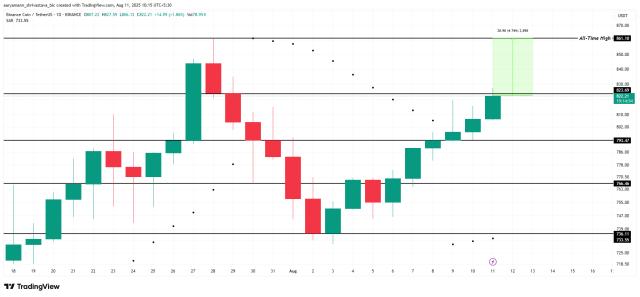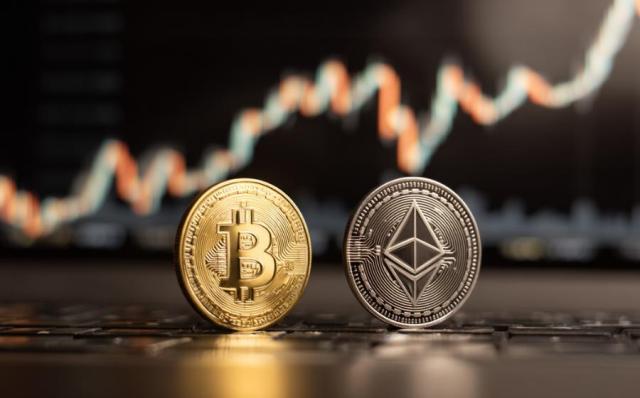
Article Source: Between the Lines
Time is the fairest existence, and everyone has time, but many people only realize that time is their greatest wealth when they lose it.
At the beginning of the year (January 3rd), we published an article about the 16th anniversary of Bitcoin, which listed the price changes of Bitcoin over the past decade along a timeline, as shown in the image below.
Press enter or click to view image in full size
I remember some friends commenting at the time, lamenting that they missed the golden period of Bitcoin's surge, and if they had bought just a few dozen bitcoins ten years ago, they would now have at least a 300-fold return.
Theoretically, this sounds plausible, but buying Bitcoin ten years ago and holding it until now is extremely difficult, as most people are incapable of such extreme patience.
1. Market is an Expression of Emotion
Time is everyone's greatest advantage, but this advantage requires sufficient patience to be fully utilized.
Especially in investing, never harbor any luck, and don't think you can always outsmart the market with your intelligence. The market doesn't care how smart you are; ultimately, the market is merely an expression of emotion. Only by overcoming our emotions and rationally hedging our rash actions can we maximize the advantage of time.
In our previous article (August 5th), we mainly discussed the topic of "opportunities" and mentioned that the market never lacks opportunities. From my personal experience, I believe waiting for opportunities is good because the market provides compound opportunities, allowing continuous accumulation and multiplicative growth.
Take Bitcoin as a simple example. By leveraging the advantages and patterns of cycles, identifying extreme market conditions, remaining calm, patiently waiting for opportunities, avoiding frequent trading and unnecessary leverage, and persisting through several cycles, you'll likely achieve good results.
Press enter or click to view image in full size
Of course, there's a premise that choosing the right target and system is more important than short-term effort. In other words, if you find an investment opportunity with an average annual return of 10% and persist long-term through compound interest, the returns after decades will be impressive. Assets like Bitcoin remain one of the best choices.
When I first entered this field, like most newcomers, I liked constantly checking exchange backends and wallet balances, focusing on income fluctuations. This resulted in emotional volatility and increasingly irrational trades, sometimes even causing losses.
As I changed my strategy, shifting from frequent trading to a cycle-based trader (making trades countable times per year), my mindset improved, and I gained more time and energy for new thinking and reflection.
Currently, I don't care if I don't trade for months, don't make money, or if my wallet experiences significant market fluctuations (USDT-denominated floating losses). I believe the market will continue rising long-term, and I'm focused on opportunities in the next 5, 10, or even 20 years, maintaining patience.
If you truly understand that the market is an emotional expression, things become simple: when people feel fear, we can oppose that fear; when people become optimistic or experience FOMO, we can start selling in batches and wait for new low-point buying opportunities.
As Warren Buffett's classic quote says: "Be fearful when others are greedy, and greedy when others are fearful." This isn't just about contrarian thinking but emphasizes emotional control in investing - investing requires rationality, not following trends.
Reality often shows that understanding principles doesn't guarantee success. In investing, experiencing losses might be the best teacher. Perhaps this is one interpretation of "a loss can be a blessing" - don't fear temporary losses, and experiencing losses early isn't bad, but you should promptly review, reflect, and summarize to avoid mindless continuous losses that ultimately eliminate you from the market.
Making more money is certainly enjoyable, but we can also consider: when making money no longer excites a person, they might be close to successful money-making. When someone still gets excited about a profitable trade, they might make larger mistakes in subsequent trades.
Ultimately, we need to learn to become calm investors, find our risk tolerance balance, and maintain focus and patience based on a broader time framework to achieve sustainable preservation and growth of our investment portfolio.
Of course, if you still believe you're a chosen one who can beat the market and capture overnight hundredfold or thousandfold opportunities like some reports suggest, you can continue gambling. I won't stop you because I can't, and I'm not obligated to.
2. Rate Cut = Bull Market?
At the current stage, although Bitcoin remains at the $110,000 level and has achieved around a 60% increase from April to now, from a retail investor perspective, people seem to be in agony.
Many retail investors thought Bitcoin at $20,000 in 2023 was too expensive to buy, at $50,000 in 2024 was too expensive to buy, and similarly, at $80,000 this year, they still wouldn't buy. As a result, many have been holding a large proportion of Altcoins waiting, and their waiting has gradually become a torment, with their goals shifting from initial 100x or 10x returns to simply breaking even. These people constantly roam comment sections of key opinion leaders, hearing them shout that the Altcoin season is yet to come, maintaining their money-making fantasies in their suffering.
Regarding the Altcoin season topic, we've discussed it extensively in previous articles, so we won't repeat that here. We just want to convey a basic principle: if the market allowed everyone to make money, where would your money come from?
Simply put, the money you/I make is money lost by others. The market's fundamental nature is liquidity, as we mentioned in previous articles: if you don't know where market liquidity comes from, you are the one providing liquidity.
People's current fantasies can be roughly divided into several types, such as:
- Fantasizing that the Federal Reserve will cut rates quickly, bringing more market liquidity and thus triggering a comprehensive Altcoin season.
- The fantasy king of Altcoins, Ethereum, is expected to quickly break through its historical high in price performance, thereby triggering a new round of comprehensive Altcoin season.
However, there is a problem that needs to be addressed: Have you made the worst-case scenario plan (i.e., creating a Plan B) for yourself? Specifically, if the Federal Reserve cuts interest rates as expected this year, and ETH breaks its historical high, but the market still doesn't bring the comprehensive Altcoin season you hoped for, and your fully loaded Altcoins still can't break even or make money, what would you do then?
Regarding the interest rate cut, I recently saw many opinions shouting: Rate cut = big bull market. Strictly speaking, I believe this statement is debatable.
Through the Federal Reserve observation tool, we can find that currently, the possibility of interest rate cuts to 3.5%-3.75% this year is 51%. As shown in the following image.
Press enter or click to view image in full size
In other words, this seems to be quite far from the market-neutral rate of 3%–3.5%, and this result should not be considered an optimistic signal, meaning that rate cuts do not necessarily directly prompt a new big bull market to arrive immediately.
Remember in the article on March 2nd, when we discussed the topic of rate cuts, we also mentioned that since last year (2024), the market has been focusing on rate cut expectations. But honestly, for the crypto market at this stage, it is at most a small market. We will receive spillover liquidity from stock and other financial markets due to rate cuts, but don't expect liquidity to primarily flood into the crypto market.
In the article on March 16th, we further added on the topic of rate cuts: In the previous bull market, it was precisely because of the extreme rate cuts in 2020 that extremely low borrowing costs and larger-scale liquidity nurtured the process of a new bull market. However, if we look back at historical price trends, we can also find that the effect of rate cuts at that time was not immediately reflected in the crypto market, and the big bull market did not break out until 2021. At the current stage, the crypto market is mainly enjoying "excess liquidity" - the large-scale liquidity brought by rate cuts will first flow into traditional markets like US stocks, and then the excess liquidity will flow into the crypto market, which is a secondary high-risk market. But this situation will gradually improve, because as more and more large institutions have begun to deeply participate in the crypto market in recent years, the crypto market has become increasingly synchronized with US stocks. Once there is large-scale liquidity in the market, a part of the funds may choose to flow into the crypto market in advance.
At that time, we also mentioned in the article: The rate cuts in 2020 and 2025 are different. Besides the different starting interest rates, the biggest difference is the speed of rate cuts. The previous round of rate cuts had a relatively large speed and magnitude, while this round (2025) currently seems to be a slow and gradual process. Therefore, for the current crypto market situation, it may continue to be a gradual market.
Additionally, in the article on April 14th, we again mentioned the topic of rate cuts and said: Do not simply think that the market will continue to rise as long as the Federal Reserve cuts rates. The relationship between rate cuts and market rise is not as simple as we imagine. For example, once the market clarifies the rate cut expectations, even before the rate cut is officially implemented, the market will likely have a wave of speculation and rise. For another example, when the official rate cut arrives, although the policy is releasing water, the market may also experience a new round of decline or a rise followed by a fall in the early stages of the rate cut. Rate cuts are definitely beneficial to the market, but do not directly equate rate cuts with price increases, because the market is always dynamic and volatile.
Many people always like to look at problems from a single perspective. They hope that the Federal Reserve can cut rates quickly because rate cuts will bring new liquidity, and new liquidity can drive the prices of risk assets to rise. But from another angle, if the probability of rate cuts increases, it also means that the economic situation in the United States (and even globally) is becoming more severe. If someone pays more attention to macro data, they would know that the current US employment data is not optimistic, the real estate market is struggling, PMI is below the boom-bust line (50), fiscal deficit continues to expand... These data and phenomena all indicate signs of economic contraction.
If we combine the market trends with these macro situations, it can be said without exaggeration that these are the important reasons for recent market volatility, but these situations currently seem unlikely to change in the short term.
Of course, precisely because the market is volatile and there are various uncertain factors, some special demands or speculation can still bring short-term price increases for some assets. For example, recently some listed companies have begun to frantically accumulate and reserve ETH, directly promoting the stage-specific rapid rebound and rise of ETH's price. But for the market, in the long term, if the macro economic situation cannot change significantly, the overall market may still remain in a relatively chaotic and volatile state, and we can hardly directly usher in the kind of comprehensive and general crazy bull market (the ideal crazy bull market people envision).
In summary, for risk assets, rate cuts are indeed something people should look forward to because rate cuts mean more liquidity. However, do not be overly optimistic just because we will see rate cuts coming. You should know that rate cuts themselves are only a key condition for catalyzing the price increases of some risk assets, not the result. From a long-term perspective, the market will not continue to rise directly due to rate cuts, but should rise continuously as economic recovery signs begin to appear.
Rate cuts are because the economic situation is deteriorating, not improving. The market may cheer and experience a short-term peak due to rate cuts, and smart money may also use rate cuts for short-term speculation to push up asset prices. But in the long term, smart money will certainly not take excessive risks. Rate cuts are not only a blessing for rising prices but also a warning. If the economic situation becomes more severe behind the rate cuts, this problem may be more serious than it appears on the surface.
Therefore, we must maintain calm thinking. Besides steadfastly holding BTC, we should try to reserve sufficient liquidity positions (cash/USDT) for ourselves.
That's all for today. The sources of images/data involved in the text have been supplemented and backed up in the Li Talks Diplomacy Group. The above content is just a personal perspective and analysis, only for learning records and communication, and does not constitute any investment advice.
Article source: https://mp.weixin.qq.com/s/JVKuixQWAa9UlrosYoQhoA







